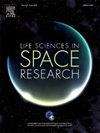Effects of neutron radiation on pharmaceuticals in deep space-like environments - general anesthesia in space
IF 2.8
3区 生物学
Q2 ASTRONOMY & ASTROPHYSICS
引用次数: 0
Abstract
In deep space environments such as the Moon and Mars, secondary radiation generated by interactions between galactic cosmic rays and spacecraft walls or planetary surfaces presents a significant challenge. In particular, the effects of neutron radiation remain insufficiently understood. This study investigates the impact of neutron radiation on pharmaceuticals, specifically the general anesthetic propofol (2,6-Diisopropylphenol). Neutron irradiation experiments were conducted using the RIKEN Accelerator-driven compact Neutron Source (RANS), employing fast neutrons with energies of 1–5 MeV at doses up to 4 Gy. Analyses employing nuclear magnetic resonance (NMR), colorimetric assessment, micelle particle size measurement via optical microscopy, and high-performance liquid chromatography (HPLC) detected no discernible alterations in the molecular structure of propofol. Furthermore radiological activation analysis using Geiger-Müller (GM) counters and γ-ray spectral analysis with the germanium detector (Ge) indicated minimal radionuclide generation in the pharmaceutical itself, however significant activation was observed in glass vials. These findings highlight container activation as a critical risk factor in the storage and transportation of pharmaceuticals in space environments.

深空环境中中子辐射对药物的影响——太空全身麻醉
在月球和火星等深空环境中,星系宇宙射线与航天器壁或行星表面相互作用产生的二次辐射提出了重大挑战。特别是,中子辐射的影响仍然没有得到充分的了解。本研究探讨中子辐射对药物的影响,特别是对全身麻醉剂异丙酚(2,6-二异丙基酚)的影响。中子辐照实验使用RIKEN加速器驱动的紧凑型中子源(RANS)进行,使用能量为1-5兆电子伏特的快中子,剂量高达4 Gy。采用核磁共振(NMR)、比色评估、光学显微镜胶束粒径测量和高效液相色谱(HPLC)的分析发现,异丙酚的分子结构没有明显的变化。此外,使用盖格-梅勒(GM)计数器和锗探测器(Ge)的γ射线光谱分析表明,药物本身的放射性核素产生很少,但在玻璃瓶中观察到明显的活化。这些发现突出表明,容器活化是在空间环境中储存和运输药品的关键风险因素。
本文章由计算机程序翻译,如有差异,请以英文原文为准。
求助全文
约1分钟内获得全文
求助全文
来源期刊

Life Sciences in Space Research
Agricultural and Biological Sciences-Agricultural and Biological Sciences (miscellaneous)
CiteScore
5.30
自引率
8.00%
发文量
69
期刊介绍:
Life Sciences in Space Research publishes high quality original research and review articles in areas previously covered by the Life Sciences section of COSPAR''s other society journal Advances in Space Research.
Life Sciences in Space Research features an editorial team of top scientists in the space radiation field and guarantees a fast turnaround time from submission to editorial decision.
 求助内容:
求助内容: 应助结果提醒方式:
应助结果提醒方式:


